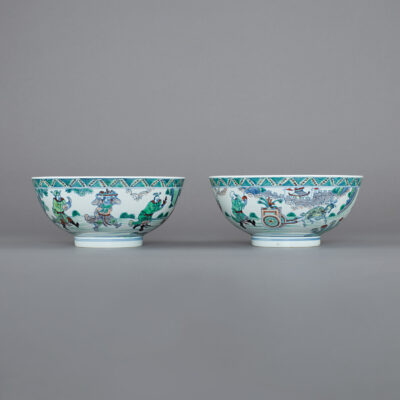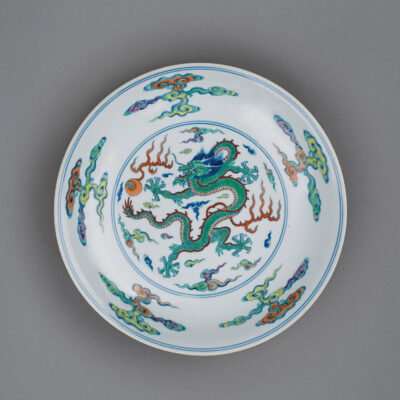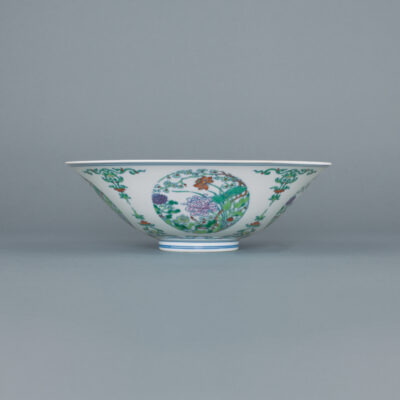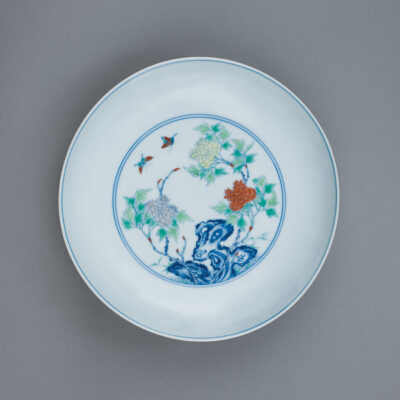


Doucai
Similar in technique to the later Wucai style, the Doucai porcelain style began during the reign of Ming dynasty Emperor Xuande in the fifteenth century and most of the Doucai pieces were made at the Imperial kilns in the southern Chinese city of Jingdezhen.
Translated as ‘contrasted colours’, ‘fitted colours’, ‘dove-tailed colours’ or ‘colours that fit together’, Doucai porcelain is made by painting designs onto the pieces in an underglaze blue and then firing them at a temperature of approximately 1100°C. Then the vessel was fired a second time once the entirety of the design was added in differing colours of overglaze enamel at a lower temperature of around 850-900°C.
The zenith of Doucai production came in a few short years during the reign of Ming dynasty Emperor Chenghua (1464 – 1487). They were mainly smaller vessels including the famous Chicken cups, small Doucai porcelain bowls commissioned by Chenghua adorned with chickens, hens and cocks as an act of devotion for his mother who valued small, delicate pieces of Doucai porcelain with simple designs.
-

10 – M5480/1
£POAPair of Chinese imperial porcelain doucai figural bowls of deep form, wan, thinly potted with upright sides, each painted on the exterior in a continuous landscape scene with five tribute bearers carrying incense bowls, an aquatic branch, a tray of fruit and a cornucopia, all following a tethered yellow-glazed deer pulling a carriage of aquatic branches and peacock feathers, approaching a walled city amongst clouds, flowers, plants and rockwork beneath a triangular diaper band at the rim and above two underglaze blue lines at the foot. The well of the interior painted with a mountainous landscape medallion with a house nestled amongst pine trees and rockwork beneath the sun and migrating birds, encircled by two double lines in underglaze blue.
-

13 – M5094
£POAChinese imperial porcelain doucai dragon saucer dish, pan, painted in the centre with a five-clawed dragon with open mouth and detailed scales in pursuit of a large iron-red flaming pearl, amongst stylised flames and ruyi-clouds all within two underglaze blue lines, the cavetto painted with five large ruyi-clouds in iron-red, aubergine, green and yellow enamels outlined in underglaze blue within two further underglaze blue lines beneath the rim. The underside with a wide band of crested foaming waves beneath clouds, all within underglaze blue double lines.
-

14 – M5280
£POAChinese imperial porcelain doucai and famille rose enamelled conical floral medallion bowl, wan, painted on the exterior with four blossoming flower medallions of peony, lotus, chrysanthemum and prunus, representing the four seasons, the branches and leaves forming the roundel, all between stylised green-glazed branches with buds and lotus petals, beneath two underglaze blue lines at the rim repeated on the foot. The well of the interior with a double butterfly medallion and a prunus flower spray, circled by two pairs of underglaze blue double lines.
-

15 – M4928
£POAChinese imperial porcelain doucai deep saucer dish, pan, painted in the centre with two branches of tree peony bearing large yellow, iron-red and aubergine blooms, amongst lime and apple-green leaves, issuing from pierced taihu rockwork, between sprays of bamboo and beneath two butterflies in flight and within two underglaze blue borders, with a further underglaze blue line beneath the rim. The exterior painted with large branches of chrysanthemum and hibiscus amongst rockwork and smaller sprays of aster, pink and bamboo, with two butterflies in flight above two underglaze blue lines and beneath a further line at the rim.
-

23 – M1407
£POAChinese imperial porcelain doucai tripod censer, san zu lu, painted on the body with the Eight Buddhist Emblems, bajixiang, each ribbon tied amongst scrolling lotus and peony flowerheads on branches with scrolls and leaves, beneath a yellow ground ruyi-head band, between two curved openwork handles with open-winged iron-red bats and aubergine bats at the terminals, the flat sides with keyfret, with a lotus flowerhead interlinked branch on the neck above a green-washed band, the relief galleried rim with iron-red keyfret, all on three cabriole feet with flowerheads and branches linked by ruyi-heads, above further keyfret at the foot.











